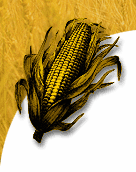

  |
|
|
Fort Detrick lab fights soybean rust disease, other crop threats
(Monday, Nov. 17, 2003 -- CropChoice news) --Elizabeth Williamson, Washington Post, 11/16/03:
In a sealed greenhouse on the edge of Fort Detrick's sprawling campus in Frederick [Maryland], scientists in hospital scrubs check rows of soybean sprouts, working to counter a threat that, if left unchecked, could devastate U.S. soybean farming.
Soybean rust, an exotic fungus easily carried by the wind, or by would-be agro-terrorists, has destroyed thousands of acres of soybean crops in Asia, Africa and South America. If it hits the United States, biologists say, it could cost farmers more than $7 billion annually in lost crops and increased expenses. That would be roughly comparable to the blow dealt to the airline industry in the months after the Sept. 11, 2001, terrorist attacks.
"It's our highest-level threat for the immediate future," said Douglas Luster, research chief at the U.S. Department of Agriculture's Foreign Disease-Weed Science Research Unit at Fort Detrick. "If it spread across hundreds of acres, it would be difficult to eradicate."
The battle against soybean rust epitomizes Fort Detrick's change in focus from Cold War-era weapons development for the military to cutting-edge biological research with civilian applications. Scientists at the U.S. Department of Agriculture center there, including some who once did Army biochemical weapons research at Fort Detrick, are working to detect and prevent crop diseases and weed infestations in the United States and other countries. The soybean rust project is the heart of a research network that extends across the nation and abroad.
"In the U.S., Fort Detrick is the only place where research work can be done with soybean rust because the fungus doesn't occur naturally here and is under containment," said Glen Hartman, a USDA research plant pathologist at the University of Illinois' Department of Crop Sciences.
In 1969, weapons research was halted at Fort Detrick, the government has said. Today, several medical and biological research organizations work there, including the Army's Medical Research Institute of Infectious Diseases and the National Cancer Institute.
The USDA laboratory was created in 1971. It is housed in space once used by the Army's Plant Sciences Directorate to test anti-crop biological and chemical weapons, including the notorious Vietnam War-era defoliant known as Agent Orange. Today, scientists work in the same greenhouses with the opposite aim: to protect global food supplies against threats, some similar to what the Army cultivated there.
The center boasts the country's biggest Biosafety Level 3 laboratory/greenhouse -- a pressurized, sealed facility where dangerous spores and agents can be isolated for testing on plants. Scientists enter through double doors and change clothes inside. Upon departing, they strip and shower, leaving behind lab clothing and equipment that are sterilized.
The greenhouse itself is protected by two layers of glass, as well as reverse pressurization that keeps contaminants inside, even if the glass is punctured. The Army recently asked the USDA to take an aerial photo of the facility off its Web site as a security measure.
The precautions reflect real dangers: Most crop diseases and weed plagues are carried by wind or hitchhike with unaware tourists from abroad. "One of the biggest fights I've ever had with my wife was over bringing an orange home from Spain," Luster said.
Since the terrorist attacks, the USDA scientists also study agents that agro-terrorists could use to threaten U.S. crops. With soybean rust, natural infestations have a more likely chance of occurring.
Soybean rust is caused by tiny spores that land on a soybean plant's broad leaves, creating reddish-brown pustules that sap the plant of nutrients that it needs to produce beans. Within two weeks, the pustules erupt, releasing spores that travel on the wind to new plants. The spores are easily carried on people, as well, raising fears that terrorists could bring them to the United States, wreaking havoc on the $13 billion a year soybean industry.
The disease was first seen in Japan in 1902. It reached Zimbabwe, a big soybean producer, in 1998. From there, it traveled so quickly that in one region, it hit while farmers were away at a fishing tournament. When they returned several days later, their fields were dead.
Reid Frederick, research molecular biologist at the Fort Detrick center, was in Zimbabwe during the infestation.
The disease-causing spores were so thick in the air that "it was like a dust storm," he said. "This is the most aggressive disease that farmers will ever see."
Soybean rust reached South America in 2001, devastating crops in Brazil and Paraguay. Against the backdrop of the terrorist attacks, the infestation raised alarms.
At Fort Detrick, 10 USDA scientists work to combat the disease in a $500,000 a year program funded by the United States and soybean growers. They collaborate with researchers in China, Thailand, Zimbabwe, Brazil and Paraguay who gather spores and field-test new plant strains developed in Frederick.
Over the past 18 months, Detrick researchers have tested more than 13,000 varieties of soybeans, searching for a rust-resistant strain. "None seem super-resistant" so far, Frederick said.
University of California researchers at a U.S. Department of Energy laboratory in Walnut Creek, Calif., are mapping the soybean rust genome to learn more about its deadliest features and how genetic engineering might be used to counteract them. Because it will be several years before a rust-resistant soybean strain is widely available for farmers, the group is working on fungicides to control the plague in case it arrives in the United States.
"We're trying to throw as many arrows at the target as we can," Frederick said. "People think we have all the diseases we're ever going to get, and then comes West Nile, or SARS. Plants are the same."
Source: http://www.washingtonpost.com/wp-dyn/articles/A46624-2003Nov15.html
See related news release: Soybean producers raise concerns over Asian Rust http://www.cropchoice.com/leadstry.asp?recid=1589 | |